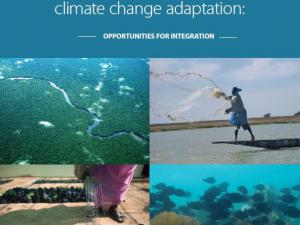Discussion Paper: Promoting ecosystems for disaster risk reduction and climate change adaptation

The discussion paper seeks to highlight the differences and commonalities between ecosystem-based approaches to adaptation (EBA) and ecosystem-based approaches to disaster risk reduction (Eco-DRR) and suggests key integration points at the project level through examining a number of Eco-DRR, EBA and hybrid (Eco-DRR/CCA) projects. A total of 38 (Eco-DRR, EBA and hybrid Eco-DRR/CCA) projects were examined in terms of their aims, assessments, implementation, monitoring and evaluation (M&E) and policy and institutional contexts to understand how in practice these approaches differ and overlap and to find key integration points. Based on the review of Eco-DRR and EBA projects, Eco-DRR and EBA in practice (i.e. at project level), have much more in common than they are different, primarily because of the sustainable ecosystem management approach that is applied in Eco-DRR and EBA. Hence, ecosystem-based approaches can help bridge the divide between DRR and CCA fields of practice.
EBA and Eco-DRR share the differences (for CCA and DRR) but have more similarities given their focus on ecosystem management, restoration and conservation to increase resilience of people (or reduce risk or reduce vulnerability). However, many EBA projects focus more on the conservation of biodiversity and ecosystem services and impacts of long-term climate change than do most Eco-DRR practice because of EBA’s roots from conservation organisations. On the other hand, Eco-DRR includes components such as early warning, preparedness and contingency planning, response, recovery and reconstruction, which EBA usually does not focus.
This paper identifies five areas for Eco-DRR and EBA integration in project design and implementation, namely:
Defining aims of the project;
1. Conducting risk and vulnerability assessments;
2. Project implementation: methods, approaches,
3. tools; Monitoring and Evaluation; and
4. Policy and institutional engagements.
5. In formulating project aims, understanding future change and project needs by creating future scenarios that takes into account climate, environment, development and multiple hazards would help indicate who would be best involved in the project and ensure future sustainability. Because both Eco-DRR and EBA are emerging fields in their own right, each are developing assessment methods and tools, in which data availability plays a large role. There is sometimes cross-over in assessment needs either result.
Log in with your EU Login account to post or comment on the platform.